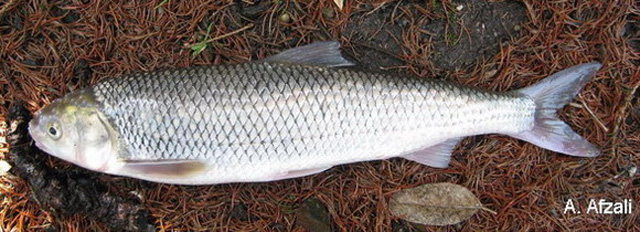| Leuciscidae (Minnows), subfamily: Leuciscinae |
| 70 cm TL (male/unsexed); max.weight: 8,000.0 g; max. reported age: 12 years |
|
benthopelagic; freshwater; brackish; depth range - 50 m |
| Eurasia: Black and Azov Sea basins, absent from Danube and Kuban drainages; landloacked populations in Don, resulting from dam construction; Caspian basin from Terek to Atrek drainages, very rarely in northern Caspian basin (Volga [earlier up to Perm], Ural); Lake Iznik in Sea of Marmara basin in Anatolia. |
|
Dorsal soft rays (total): 11-12; Anal soft rays: 12-14. Can be diagnosed from its congeners in Black and Caspian Sea basins by having the following characters: body almost cylindrical, depth 19-26% SL; 53-64 + 3 scales on lateral line; abdomen posterior to pelvic rounded; snout rounded, stout; mouth subterminal; dorsal fin with 9-10½ branched rays; iris and fins grey or slightly yellowish; breeding males with large, scattered tubercles on top and side of head (Ref. 59043). |
| A semi-anadromous species which occurs in large brackish estuaries and their large, freshened plume waters, coastal lakes connected to rivers and lowland stretches of large rivers. Can tolerate salinities up to 7-12 ppt. Landlocked populations live in lakes or reservoirs. Larvae and early juveniles take zooplankton, algae and insect larvae as food while adults feed on molluscs, Rhithropanopeus crabs and other benthic invertebrates. Feeding ceases while migrating, spawning and overwintering. Breeds in small rivers or streams with heavy current on gravel bottom. Begins migration to rivers in second half of October (Black Sea, rarely in Caspian Sea). When rivers are covered with ice, spawning migration stops and continues when ice breaks up or even under ice in February-April. Spawns in April-May. Adults migrate back to estuaries to forage immediately after spawning. Juveniles move to estuaries during first summer in August. Landlocked populations undertake migration in springs from lakes or reservoirs or middle stretches of rivers to tributaries or upper reaches (Ref. 59043). |
|
Least Concern (LC); Date assessed: 01 January 2008 Ref. (130435)
|
| harmless |
Source and more info: www.fishbase.org. For personal, classroom, and other internal use only. Not for publication.

